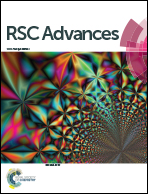Exploration of 6,7-dimethoxyquinazoline derivatives as dual acting α1- and AT1-receptor antagonists: synthesis, evaluation, pharmacophore & 3D-QSAR modeling and receptor docking studies†
Abstract
The 6,7-dimethoxyquinazoline scaffold was further explored to provide dual acting α1- and AT1-receptor antagonists by synthesizing a series of derivatives and biologically evaluating the newly synthesized compounds. Based on the biological data of the current compounds and the earlier reported compounds, pharmacophore models were developed for α1- and AT1-receptor antagonist activities. Subsequently, 3D-QSAR models were also derived for antagonism for both the receptors. The developed 3D-QSAR models were validated using various statistical parameters and both the developed models were further validated using terazosin and prazosin as external compounds. Docking studies confirmed receptor–ligand stabilizing interactions of the balanced-dual active antagonist (110) in the active sites of both α1- as well as AT1-receptors, the structures of which were obtained by homology modeling. Two (42 and 110) of the compounds from the newly synthesized derivatives offered the highest potency (pA2 for α1 = 9.45 and 8.77 and AT1 = 8.36 and 8.60 respectively) with balanced modulation of both the receptors. Both the compounds were found to be slightly less potent to terazosin as α1-antagonists and equipotent to losartan as AT1-antagonists in the in vivo animal model.


 Please wait while we load your content...
Please wait while we load your content...